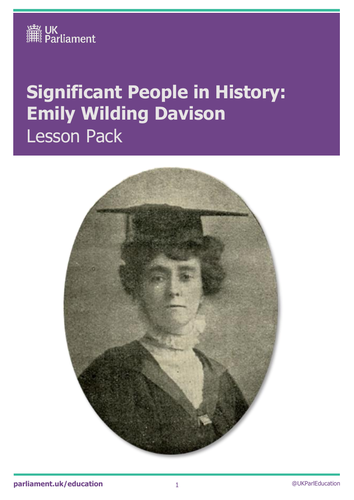22Uploads
237k+Views
127k+Downloads
History

Emily Wilding Davison primary assembly and lesson plan
The word ‘suffrage’ means having the right to vote in political elections. The suffragettes were women who campaigned for this right. In this presentation pupils find out about Emily Wilding Davison, a suffragette who campaigned for equal rights for women.

Guy Fawkes and Bonfire Night, presentation
Use this PowerPoint as an introduction to the story of Guy Fawkes and the origins of Bonfire night.

Votes for Women, video and resource pack
An audio drama following Suffragette Lady Constance Lytton as she protests for women’s right to vote, accompanied by plans to utilise this as part of a debate-based lesson or assembly.

First Mass Petition, Votes for Women
Link to interactive resource: http://www.teach1866petition.com/
An online resource with supporting worksheets that brings the women’s suffrage campaign to life for students aged 11-16. The resource explores the 1866 petition which called for women’s right to vote and was signed by women across the United Kingdom.
Students follow the journey of the suffrage campaign through video, audio and quizzes, while source based activities help pupils develop source analysis skills. The supporting regional worksheets provide a local history focus for students to learn more about suffrage campaigning and key women in their area.
The resource is designed for students to use independently using a tablet or computer. It is split into distinct chapters so that students follow the story from start to finish. Prior to the lesson, teachers can download supporting worksheets which are designed to be completed separately once students have worked through the online resource.
Students will learn about:
The 1866 petition, how it started, how it was debated in Parliament and how it sparked a nationwide movement
What life was like in 1866 and the rights women had
The 1866 petition in more detail, testing out their source analysis skills and discovering how many people signed in their area

Simon de Montfort, video
Simon de Montfort’s Parliament represented a crucial step on the path to parliamentary democracy. For the first time, it brought together representatives from different towns and cities – a principle which can be seen reflected in the make-up of the modern House of Commons.
Bring the story of Simon de Montfort and his 1265 Parliament to life with this video drama and explore the emergence of Parliament and local representation.
These resources are suitable for Citizenship lessons exploring the origins of local representation in Parliament, or History, specifically as part of the KS3 ‘Magna Carta and the Emergence of Parliament’ curriculum.
All images subject to copyright, click here for more information.

UK Parliament and World War II (primary)
This video and accompanying resource pack explores the role of UK Parliament in WWII.
Pupils will learn about some of the laws passed during World War II, including the rationing of food and the evacuation of children from cities when the bombs began to fall. They will learn that Parliament was bombed during the Blitz and that the House of Commons Chamber was completely destroyed. They will also find out about some of the important laws that were passed after the war to help rebuild Britain, one of which was the National Health Service Act which created the NHS.

Magna Carta for the 21st century, video
Encourage students to consider how Magna Carta still affects our rights and responsibilities today and which rights and freedoms they feel are important enough to be enshrined in their own ‘Magna Carta for the 21st century’.

World War One and Parliament, video and resource pack
Watch the video and use the resource pack, including two re-enacted speeches, to support your students to develop historical research, analysis and presentation skills. This will enable students to answer key questions about the role of Parliament in the outbreak of WWI.

UK Parliament and World War II (secondary)
This video and accompanying resource pack explores the role of UK Parliament in WWII.
Your students will learn about the laws passed at the start of the war, including conscription into the armed forces. They will question Parliament’s ability to scrutinise Churchill’s coalition government and explore specific challenges made by members of Parliament about decisions made.
They will learn that the House of Commons Chamber was destroyed during the Blitz and the measures in place to ensure that Parliament could continue to function throughout the war.
Finally, they will be introduced to some of the post-war legislation passed to help Britain rebuild, including the creation of the National Health Service.









